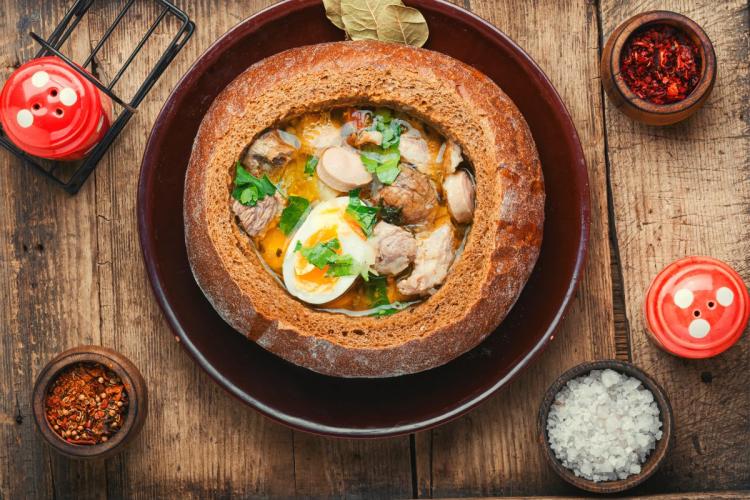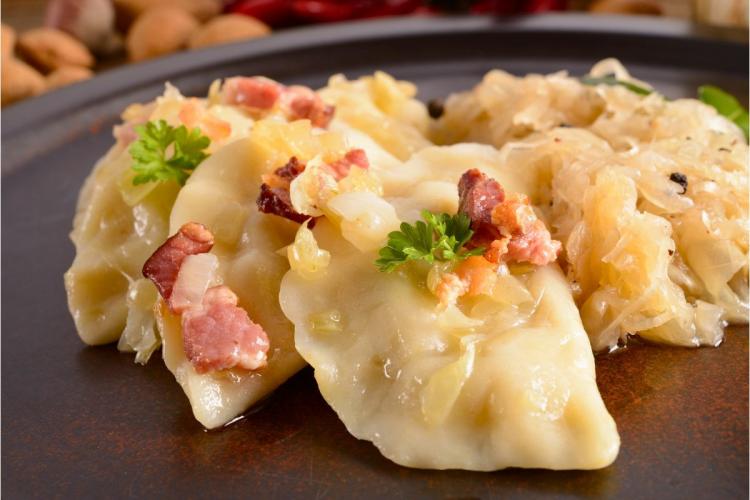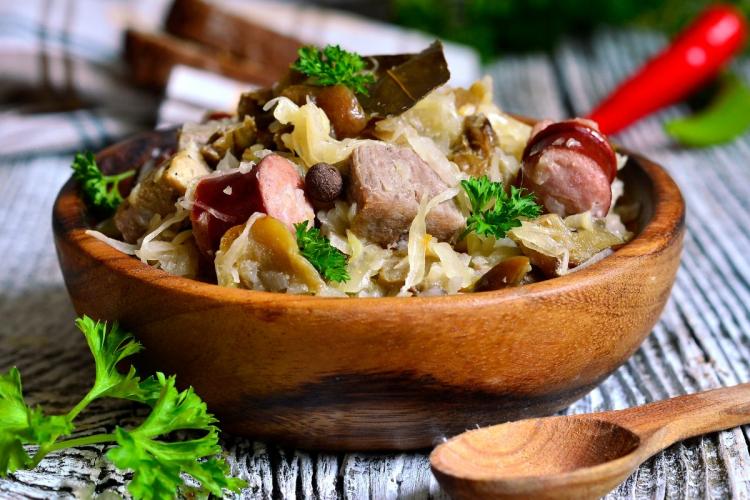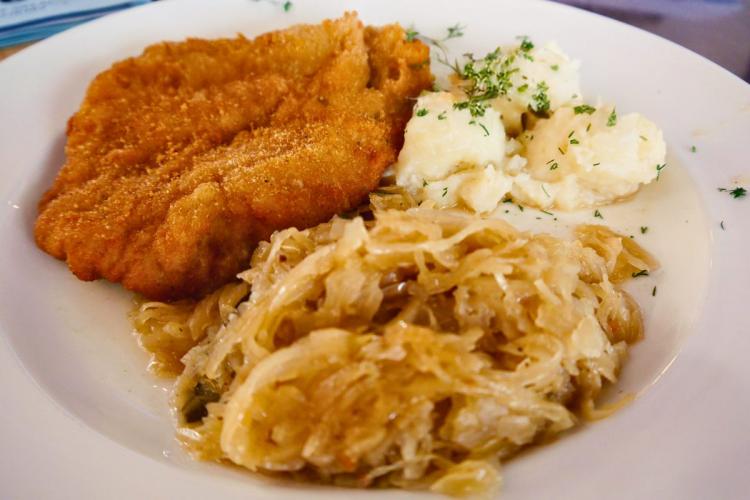Food in Poland
Discover the best traditional Polish food.
What makes Polish cuisine special? The food in Poland is a delightful mix of rich flavors and hearty dishes that reflect its history. Let’s dive into the traditional dishes that make Polish food unique.
Polish cuisine
- Polish cuisine is a diverse blend influenced by Italian chefs, Jewish communities, and the use of spices, evolving through historical events to create hearty dishes suited for harsh winters.
- Signature Polish dishes such as pierogi, bigos, golabki, kotlet schabowy, and zurek are celebrated for their unique flavors and traditional preparation methods, each narrating a piece of Polish culinary heritage.
- Poland’s culinary landscape is enriched by regional specialties like Silesian kluski, oscypek, and kaszanka, along with a variety of traditional beverages including mead, vodka, kompot, and kvass, reflecting the country’s cultural and geographical diversity.
A brief history of Polish cuisine
Polish cuisine is a rich tapestry of diverse cultural influences, showcasing the nation’s encounters with various culinary traditions throughout its history. Some of the key influences on Polish cuisine include:
- Italian chefs during the Renaissance, who brought a flair for fresh vegetables and sophisticated techniques to Polish food
- Spices like saffron, ginger, and cinnamon, which arrived and added zest to dishes, reflecting Poland’s openness to exotic flavors
- Jewish communities, who brought delicacies such as bagels and babka, enriching the country’s gastronomic tapestry
These influences have shaped Polish cuisine into the delicious and diverse cuisine it is today.
Historical events have shaped traditional Polish food, where dishes evolved to survive harsh winters. Preservation techniques like pickling and smoking were employed, while ingredients such as honey and horseradish enriched the country’s flavor palette. This confluence of necessity and innovation gave rise to Polish culinary tradition, marked by hearty meat dishes, the extensive use of cereals and grains, and a penchant for dairy products like cream and cheese. Today, each Polish dish is a celebration of a culture that has thrived through the centuries.
Must-try traditional Polish dishes
Take a flavorful journey through famous Polish dishes that define Polish cuisine. Be it the renowned pierogi or robust zurek soup, each dish narrates a chapter of Poland’s culinary heritage. These traditional Polish recipes showcase a balance of savory and hearty elements that are the hallmark of Polish cooking, inviting both newcomers and connoisseurs alike to savor the depth of Poland’s gastronomic delights.
Pierogi
Pierogi, the adored Polish dumplings, stand as culinary ambassadors, encapsulating the essence of traditional Polish cuisine. Crafted from thinly rolled-out dough, these versatile parcels can be filled with an array of savory or sweet ingredients, such as farmer’s cheese and potatoes, cabbage and mushrooms, or even fruits for a delightful twist. Whether boiled to a tender perfection or fried for a crispy exterior, pierogi are often adorned with a dollop of sour cream, a sprinkle of fresh herbs, or a sizzle of fried onions, creating a symphony of flavors in every bite.
The variety of fillings for pierogi reflects the local ingredients and the creative spirit of Polish cooks. Some popular fillings include:
- Minced meat
- Cottage cheese
- Sauerkraut
- Potatoes
- Mushrooms
- Fruit (such as blueberries or strawberries)
- Raisins
The humble pierogi, whether enjoyed during a festive celebration or as a comforting meal on a cool evening, continues to be one of the most popular Polish foods, beloved across generations and borders.
Bigos (hunter's stew)
Bigos, also known as hunter’s stew, is a hearty dish with a rich backstory that matches its flavor. Hailed as Poland’s national dish, it is a hearty amalgamation of sauerkraut, fresh cabbage, and a medley of meats, simmered together to create a stew that’s deeply satisfying. The tradition of preparing bigos stretches back to the noble tables of the 17th and 18th centuries, where the dish was a symbol of wealth and hospitality, and today it continues to be a staple at Polish gatherings and a testament to the nation’s love for meat and sauerkraut.
The heart of bigos lies in its slow-cooking process, where the flavors of smoked sausage, bacon, and assorted meats blend with the tangy sauerkraut, creating a robust yet nuanced flavor profile. Each family’s recipe for bigos is a closely guarded secret, often passed down through generations and adapted to include local ingredients and personal tastes, making each pot of this beloved stew a unique culinary expression of Polish culture.
Golabki (cabbage rolls)
Golabki, Polish cabbage rolls, epitomize comfort food, featuring soft cabbage leaves enveloping a warm filling of rice, ground meat, onions, and a variety of spices. Served in a rich, creamy tomato sauce, golabki is a dish that speaks to the soul, offering a taste of home-cooked goodness that has been cherished in Polish kitchens for generations. Whether accompanied by boiled potatoes or a slice of rye bread, these rolls are a testament to the ingenuity of Polish cooking, where simple ingredients are transformed into a meal of remarkable depth and flavor.
The preparation of golabki is a labor of love, with each cabbage leaf carefully blanched and stuffed before being baked to perfection. The dish’s name, which translates to “little pigeons,” whimsically captures the visual appeal of these rolls, resembling small, plump birds ready to take flight. While the classic filling features minced beef or pork, regional variations and seasonal ingredients often find their way into the mix, ensuring that golabki remains a dynamic and evolving dish within the traditional Polish culinary repertoire.
Kotlet schabowy (Breaded pork cutlet)
Kotlet schabowy, the breaded pork cutlet, has a firm place in Polish cuisine. It shares similarities with the Wiener Schnitzel but carries a distinctly Polish twist. This culinary icon, with its origins dating back to the 19th century, has cemented its place at Polish dinner tables, satisfying appetites with its tender meat and crispy golden crust. The cutlet’s universal appeal among young and old alike is a testament to its timeless charm and the communal joy it brings when served alongside traditional sides like mashed potatoes or tangy sauerkraut.
The secret to a perfect Kotlet Schabowy lies in the quality of the pork and the mastery of breading, ensuring each cutlet achieves the ideal balance of juiciness and crunch. It is a dish that resonates with the simplicity and heartiness of Polish home cooking, epitomizing the notion of a comforting meal that gathers family and friends around the table.
Zurek (sour rye soup)
Zurek, the sour rye soup, holds a unique position in the realm of Polish cuisine. This tangy concoction, made from fermented rye flour known as zakwas, is a humble dish with a complex flavor profile that is both nourishing and invigorating. Often graced with hearty additions like:
- sausage
- bacon
- potatoes
- boiled eggs
Zurek is a versatile soup that can be tailored to suit any palate, making it a beloved dish across the many regions of Poland.
The origins of zurek are steeped in folklore, with tales of its accidental creation adding to its mystique. Whether it was born from a farmer’s uncleaned pot or a miserly baker’s challenge, zurek has evolved into a culinary symbol of Polish resourcefulness and tradition. With each family imparting their unique twist on the recipe, zurek remains a cherished and defining element of Polish food culture, particularly during the Easter season when it is enjoyed with special fervor.
Delicious Polish soups
Moving beyond the heartiness of main dishes, a world of comforting Polish soups awaits, offering a soothing experience with every spoonful. These broths and stews are not mere starters but meals in their own right, each with a character that reflects the soul of Polish cuisine.
From the vibrant barszcz to the wholesome rosol, popular Polish food, especially soups, are a testament to the country’s love for dishes that are as nourishing as they are delicious.
Barszcz (borscht, red beet doup)
Barszcz, the iconic beet soup of Poland, is a vibrant reflection of the country’s culinary creativity. Its stunning red hue, derived from the earthy beetroots, makes it not only a visual delight but also a flavorful marvel, with a base that harmonizes the sweetness of beets with the savory notes of onions, carrots, and potatoes. Traditionally savored during Christmas dinners, barszcz has a cherished place in Polish celebrations, often served with delicate mushroom pierogi known as uszka, adding a textural contrast and an extra layer of flavor to the experience.
Barszcz’s appeal lies in its versatility, enjoyed steaming hot to warm the winter chill or chilled for a refreshing summer treat. Its unique taste, enhanced with a dollop of sour cream and a sprinkle of dill, is a culinary masterpiece that has captured the hearts and palates of Poles for generations.
Rosol (chicken soup)
Rosol, the cherished Polish chicken soup, is a dish deeply rooted in tradition and comfort. Simmering chicken alongside aromatic vegetables like carrots, celery, and onions creates a broth that is both robust and soothing, embodying the essence of home and hearth. The gentle technique of slow-simmering, never boiling, ensures that each spoonful of rosol is infused with the full depth of its ingredients, offering a restorative warmth that is especially appreciated during Poland’s colder months.
Beyond its role as a culinary delight, rosol is also revered as a traditional remedy for the common cold and flu, a testament to its nurturing qualities. Its place at the Polish table extends to festive celebrations, where it serves as a soul-soothing prelude to the main course, cementing its status as a timeless classic of Polish cuisine.
Chlodnik (cold beet soup)
Chlodnik, the cold beet soup, adds a refreshing touch to Poland’s soup selection, offering a cool relief on warm days. Crafted from tender young beets, this chilled soup boasts a smooth base that is enlivened by the tang of yogurt or buttermilk, creating a balance of earthy sweetness and zesty tang. Garnished with boiled eggs and chopped dill, chlodnik’s vibrant color and flavors make it a visually striking and palate-pleasing dish that is both light and satisfying.
The preparation of chlodnik is a celebration of seasonal ingredients, with the best flavor coming from the use of fresh, young beets along with their roots and leaves. Whether enjoyed as a standalone meal or as an accompaniment to grilled meats, chlodnik is a testament to the versatility and creativity of Polish soup-making, offering a culinary experience that is as delightful to the senses as it is to the taste buds.
Popular Polish street foods
Step onto Poland’s bustling streets, and a kaleidoscope of aromas and flavors from the vibrant street food scene greets you. From the sizzle of grilled kielbasa to the crunch of fresh zapiekanka, Polish street food is a dynamic and delicious reflection of the country’s culinary culture, offering quick, tasty, and filling options that cater to every craving.
Zapiekanka
Zapiekanka, a mainstay of Polish street food, caters to the universal desire for fast and satisfying snacks. This open-faced baguette, reminiscent of a pizza, is a canvas for a variety of toppings, with the classic combination of sautéed mushrooms, melted cheese, and a drizzle of ketchup creating a simple yet irresistible treat. Originated in the communist era as an affordable and filling snack, zapiekanka has evolved over the years, with street vendors now offering an array of toppings that allow for endless customization, meeting the modern palate’s desire for diversity and flavor.
The allure of zapiekanka lies in its smoky flavor, achieved from being toasted on a grill, often over charcoal. This method not only imparts a distinctive taste but also ensures that the baguette is perfectly crisp, providing a textural contrast to the soft, savory toppings.
Whether enjoyed during a quick lunch break or as a late-night snack, zapiekanka remains a beloved fixture of Polish street-side cuisine, celebrated for its flavor and its ability to bring people together in shared enjoyment.
Kielbasa
Kielbasa, the archetypal Polish sausage, represents the nation’s rich charcuterie tradition. Available in various forms, from smoked to fresh, and made from a range of meats including pork, beef, and even turkey, kielbasa is a versatile ingredient that is deeply embedded in Polish food culture. When served as street food, it is often enjoyed simply, paired with a slice of fresh bread and a dollop of mustard or ketchup, allowing the robust flavors of the sausage to shine through.
The popularity of kielbasa as street food is undeniable, with its smoky aroma luring passersby to savor a taste of tradition. It’s not just a sausage; it’s a culinary experience that connects people to the heart of Polish gastronomy. Whether grilled over an open flame or nestled in a warm bun, kielbasa is a treat that satisfies the soul as much as it does the appetite, making it an enduring favorite among locals and tourists alike.
Placki ziemniaczane (potato pancakes)
Placki ziemniaczane, the Polish potato pancakes, symbolize the country’s affection for potatoes. These savory pancakes are a traditional dish made with:
- grated potatoes
- onions
- eggs
- flour
They are fried to golden perfection and served hot. Placki Ziemniaczane offer a crispy exterior that gives way to a soft, flavorful interior, making them irresistible to anyone who tries them. The simplicity of the ingredients belies the skill required to achieve the perfect texture and taste that makes placki ziemniaczane a popular choice in Polish street food repertoire.
Typically accompanied by a dollop of sour cream or applesauce, these pancakes can also be savored with goulash or a mushroom sauce, adding a rich depth to the dish. Their versatility and delicious taste make them a favorite for a quick snack or a hearty meal, embodying the soul of Polish culinary ingenuity.
Whether for breakfast, lunch, or dinner, placki ziemniaczane are a beloved staple, showcasing the rustic charm and comforting flavors that are at the heart of Polish cooking.
Traditional Polish desserts
Polish cuisine’s appeal extends beyond savory dishes; traditional Polish desserts offer a range of sweet delights that captivate the senses. From the decadent and indulgent to the light and airy, these treats are the crowning glory of Polish meals, adding a sweet note to any dining experience.
Whether you’re indulging in a fluffy pączki, slicing into a rich makowiec, or savoring the creamy texture of sernik, Polish desserts are delectable treasures that reflect the country’s love for festive and flavorful confections.
Pączki
Pączki, the emblematic Polish doughnuts, symbolize Poland’s sweet culinary legacy, especially honored on Fat Thursday, the last Thursday before Lent. These deep-fried pastries are filled with a variety of sweet fillings, from traditional rose petal jam to contemporary flavors like chocolate or custard, each bite a fusion of soft dough and rich, luscious filling. The tradition of enjoying pączki is deeply ingrained in Polish culture, with bakeries bustling with customers eager to savor these treats, often dusted with a fine layer of powdered sugar for an extra touch of sweetness.
The joy of biting into a pączki is more than a momentary pleasure; it’s a ritual that brings together families and communities in a celebration of taste and tradition. Available throughout the year, these doughnuts are especially significant on Fat Thursday, when indulging in pączki is believed to bring good luck. With their fluffy texture and irresistible flavors, pączki are not just a dessert but a cherished part of Polish celebrations, embodying the festive spirit and the nation’s love for sweet indulgences.
Makowiec (poppy seed roll)
Makowiec, the poppy seed roll, adorns tables during Polish Christmas and Easter celebrations, the sweet poppy seed filling spiral demonstrating the country’s baking skills. The rich, bittersweet filling, made from ground poppy seeds combined with honey, sugar, butter, and sometimes raisins or nuts, is enveloped by a soft yeast dough, resulting in a cake that is both visually striking and deeply satisfying.
Makowiec’s distinctive features include:
- A sweet poppy seed filling
- A soft yeast dough
- A spiral shape
- A rich, bittersweet flavor
- Optional additions of raisins or nuts
This dessert is cherished by Poles of all ages as a symbol of festive joy and culinary tradition in its polish version.
The preparation of makowiec is an art, with each baker bringing their personal touch to the recipe. Some variations include:
- Adding spices such as cinnamon or nutmeg to the filling
- Experimenting with different textures for the filling, such as adding ground almonds or walnuts
- Trying different methods of rolling the dough, such as a spiral or a braid
This dessert is not merely a treat; it is a cultural artifact, representing the care and attention that Polish bakers invest in their craft. Whether enjoyed with a cup of tea or as the finale to a holiday feast, makowiec is a dessert that celebrates the richness of Polish food culture, offering a taste that is as memorable as it is delicious.
Sernik (cheesecake)
Sernik, Poland’s take on cheesecake, is a creamy delicacy known for its unique texture and flavor, resulting from the use of twarog, a farmer’s cheese variant. Unlike its American counterpart, Polish sernik is less sweet and more dense, often enhanced with a hint of vanilla or the zest of a lemon to add a subtle aromatic quality to the cake. This dessert is a staple in Polish bakeries and homes, served as a celebratory treat or a comforting end to a family meal, its creamy richness a perfect counterpoint to the savory dishes that precede it.
Sernik’s enduring popularity is a testament to its versatility, with variations that include the addition of fruits, chocolate, or a crumbly streusel topping, each adding a unique twist to the classic recipe. The experience of savoring a slice of sernik is one that connects the eater to generations of Polish baking, offering a taste that is both nostalgic and timeless.
Whether as a simple, unadorned slice or a more elaborate creation, sernik is a dessert that captures the essence of Polish hospitality and the joy of sharing good food with loved ones.
Regional specialties
In addition to national favorites, Poland’s culinary landscape boasts regional specialties that provide insight into the unique local traditions and flavors of each area. From the smoky cheeses of the Tatra Mountains to the hearty rye soups of Silesia, these dishes are a celebration of the country’s geographical and cultural diversity, each region contributing its distinct culinary voice to the chorus of Polish gastronomy.
Silesian kluski (Silesian dumplings)
Silesian Kluski, also known as Kluski Slaskie, are a delicacy from Silesia. They are recognized by their round, dimpled shape and unique, slightly gummy texture, similar to Japanese mochi. Made primarily from mashed potatoes and potato starch, these dumplings are a testament to the resourcefulness of Polish cooks who have mastered the art of transforming humble ingredients into a dish with a distinct identity. Often served with rich gravies or mushroom sauces, Silesian kluski are a comforting presence on the Silesian dinner table, their chewy texture providing a satisfying contrast to tender beef roulades or other meat dishes.
The making of Silesian kluski is steeped in tradition, with each family passing down their version of the recipe through generations. This regional specialty not only offers a taste of Silesian culinary heritage but also reflects the broader story of Polish cuisine, where regional influences and local ingredients combine to create dishes that are as diverse as they are delicious.
Oscypek (smoked cheese)
Oscypek, the smoked cheese from the Tatra Mountains, transcends being just a dairy product, serving as a symbol of Polish mountain culture. Traditionally made from the milk of Tatra sheep, this spindle-shaped cheese undergoes a smoking process in wooden huts or ovens, giving it a distinctive smoky flavor and aroma that is highly prized. Often served grilled with a dollop of tart cranberry sauce, oscypek is a beloved street food and a culinary treasure that showcases the rich flavors of Polish highland cuisine.
The craft of making oscypek is protected by European Union subsidies, ensuring that the traditional methods are preserved for future generations. This delicious cheese, along with other regional dishes from the Tatra Mountains like creamy bryndza, sweet cottage cheese, and tangy sauerkraft soup kwanica, speaks to the deep connection between the people and the land, and the pride they take in their culinary traditions.
Kaszanka (blood sausage)
Kaszanka, Poland’s version of blood sausage, is a rustic dish that encapsulates the no-waste philosophy of traditional Polish cooking. Made with a combination of pig’s blood, buckwheat, and an assortment of spices like marjoram and black pepper, kaszanka is a flavorful and nutrient-rich sausage that has long been a part of the Polish diet. It is typically grilled or fried and often served with hearty sides like potatoes or sauerkraut, creating a meal that is both filling and flavorful.
The bold flavors and rich texture of kaszanka make it a favorite among those who appreciate the depth of traditional Polish foods. Its presence at markets and fairs is a reminder of Poland’s agricultural roots and the enduring appeal of dishes that are steeped in history and local customs.
Whether enjoyed as a simple meal on a cold day or as part of a larger feast, kaszanka is a testament to the rich tapestry of regional specialties that contribute to the diversity of Polish cuisine.
Beverages in Polish cuisine
Polish cuisine goes beyond solid food; it also offers a variety of beverages that pair well with meals and mirror the country’s cultural traditions. From the homemade non-alcoholic drinks like kompot and kvass to the traditional alcoholic beverages like mead and vodka, the Polish drink spectrum is as varied as the dishes they accompany. These beverages, whether meant to refresh or to celebrate, are integral to the complete Polish dining experience, offering a glimpse into the customs and tastes of Poland.
Mead and vodka
Mead, among the oldest alcoholic drinks known to humans, has a deep-seated presence in Polish history, often tied to ancient rituals and celebrations. This fermented honey beverage is a cherished part of Polish heritage, enjoyed for its sweet, complex flavors and its connection to the natural bounty of the land. Polish mead varies in strength and sweetness, with each variety offering a different taste profile that is best enjoyed slowly, sipped during special occasions or as a warming drink during the cooler months.
Vodka, arguably the most well-known Polish spirit, is a cultural mainstay, playing a significant role in the country’s social and culinary spheres. While plain vodka is enjoyed for its purity and smoothness, flavored varieties like nalewka, infused with fruits, herbs, or spices, are particularly popular for their rich, aromatic qualities. Vodka is more than just a beverage in Poland; it is a symbol of hospitality and celebration, often served to welcome guests and toast to good health and happiness.
Kompot and kvass
Kompot, a traditional sweetened fruit drink made by boiling a variety of fruits like apples, cherries, and strawberries, is a typical Polish beverage usually associated with family dinners and festive meals. Its preparation is simple, yet the result is a deeply refreshing drink that captures the essence of the fruits used, making it a favorite among children and adults alike. Served cold, kompot provides a perfect counterbalance to the rich and hearty dishes of Polish cuisine, offering a light and fruity finish to any meal.
Contrastingly, Kvass is a fermented beverage with a history as rich as its flavor. Made from rye bread, kvass is commonly consumed in Polish households for its unique sour taste and its reputation as a healthy, probiotic-rich drink. While traditionally prepared at home, kvass can also be found commercially produced, offering a taste that is reminiscent of the old world, with a slightly effervescent kick that is both invigorating and satisfying. Whether enjoyed as a midday refreshment or as an accompaniment to a meal, kvass is a testament to the timeless appeal of traditional Polish beverages.
Looking at traditional Polish cuisine
From the hearty stews and comforting dumplings to the refreshing soups and sweet desserts, Polish cuisine offers a rich and varied tapestry of flavors that are deeply rooted in the country’s history and regional diversity. Each dish and beverage tells a story of tradition, community, and the love of good food, inviting diners to explore the depth and breadth of Poland’s culinary heritage. As we conclude our gastronomic journey, let us carry with us the warmth and generosity of Polish tables, where every meal is an opportunity to gather, celebrate, and savor life’s simple pleasures.
What is the origin of pierogi in Polish cuisine?
Pierogi have a long history in Polish cuisine, originating from the diverse cultural influences in Poland. They are versatile dumplings filled with savory or sweet fillings that have become a beloved traditional dish.
How is bigos, their hunter's stew, significant to Polish culinary tradition?
Bigos, also known as "hunter's stew," holds great significance in Polish culinary tradition as it is considered Poland's national dish. It reflects Poland's love for hearty and flavorful stews.
Are there any Polish soups that are served cold?
Yes, Chlodnik is a popular Polish cold soup made with young beets and yogurt, perfect for warmer weather.
What makes sernik different from other types of cheesecake?
Sernik is different from other types of cheesecake because it is made with twarog (farmer's cheese), resulting in a denser and less sweet profile, often flavored with vanilla or lemon zest.
What are some traditional Polish beverages?
Traditional Polish beverages include kompot, a sweetened fruit drink, and kvass, a fermented beverage made from rye bread. Additionally, Poland is known for alcoholic drinks like mead and flavored vodka, such as nalewka.








